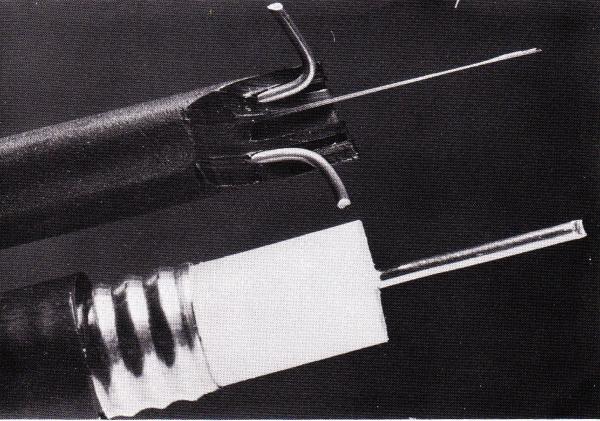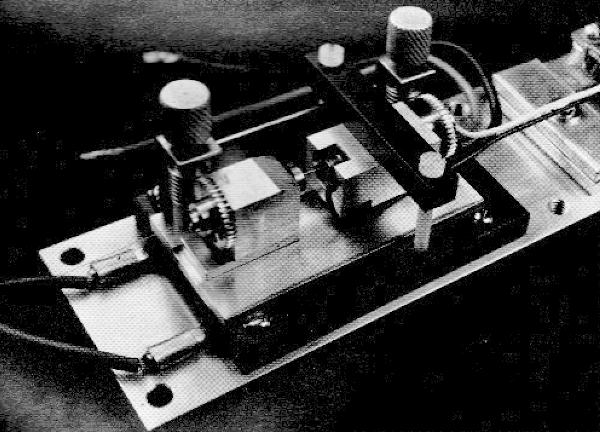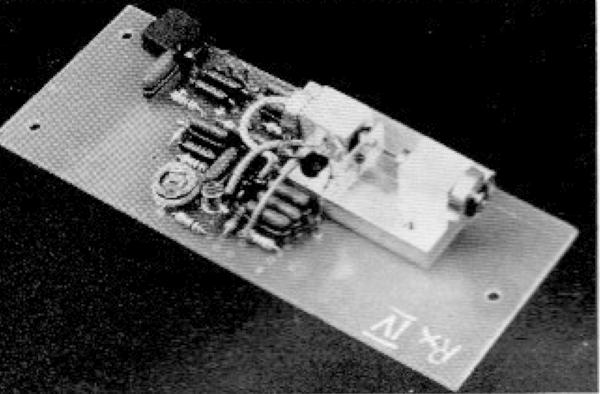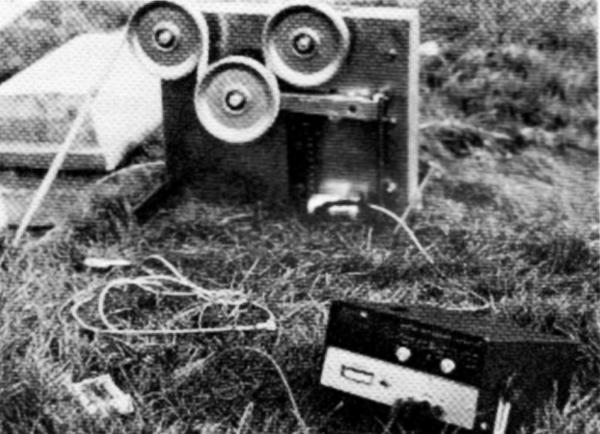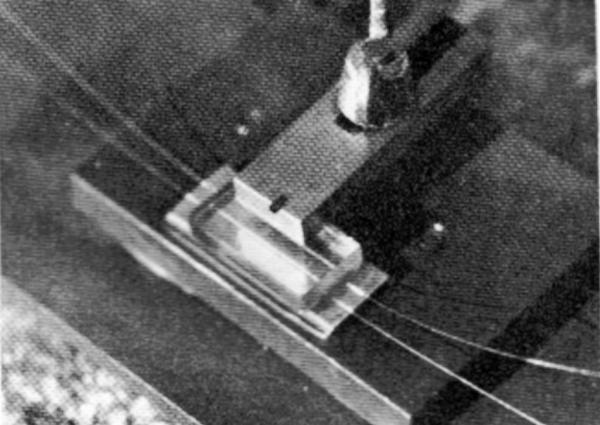

Rediffusion Fibre Optics in Cable TV :

Associated Companies in over 175 towns in Great Britain and in Barbados, Bermuda. Canada, Ceylon, Guyana,
Hong Kong, Jamaica, Malaya, Malta, Singapore, South Africa, Trinidad and West Africa etc.
Hong Kong, Jamaica, Malaya, Malta, Singapore, South Africa, Trinidad and West Africa etc.
REDIFFUSION ENGINEERING LIMITED
Carlton House, Lower Regent Street
LONDON SW1Y 4LS
LONDON SW1Y 4LS
On Monday 19 March 1976 Rediffusion and BICC gave a joint demonstration to the national media of the fibre optic link at Hastings which had been shown the previous November to delegates attending the 100th Engineering Conference.
lntroducing the demonstration, Lord De La Warr, Managing Director of Rediffusion Limited at that time, made the following statement:
"The idea that a glass fibre of very small diameter might one day be able to carry a light signal for a considerable distance has fascinated the telecommunications world for some years. The fact that ordinary glass which is only a few inches thick is difficult to see through is an everyday observation, so that the task of sending light through a glass rod a mile long seemed formidable indeed. However, the resources of modern technology are very great, and with many scientists working in many laboratories the problem has been solved in an astonishingly short time. So the official spokesman of the Bell Laboratories was saying only in October last year that practical application of glass fibres would not arrive before the 1980's. Well be that as it may, glass fibres are here now in March 1976, entering the day-to-day service of our 34,000 subscribers to cable television in Hastings."
lntroducing the demonstration, Lord De La Warr, Managing Director of Rediffusion Limited at that time, made the following statement:
"The idea that a glass fibre of very small diameter might one day be able to carry a light signal for a considerable distance has fascinated the telecommunications world for some years. The fact that ordinary glass which is only a few inches thick is difficult to see through is an everyday observation, so that the task of sending light through a glass rod a mile long seemed formidable indeed. However, the resources of modern technology are very great, and with many scientists working in many laboratories the problem has been solved in an astonishingly short time. So the official spokesman of the Bell Laboratories was saying only in October last year that practical application of glass fibres would not arrive before the 1980's. Well be that as it may, glass fibres are here now in March 1976, entering the day-to-day service of our 34,000 subscribers to cable television in Hastings."
The field trial which was set up in Hastings was part of a programme designed to determine the applicability of fibre optics to the distribution of television programmes and to obtain familiarity with the many new techniques which it employed. It would break
new ground in several areas, and was believed to be the first optical fibre link to be installed in a working system to be used by the paying public, anywhere in the world.
Also, although the transmission of television signals had
been demonstrated in several laboratories, these had generally operated at base band (i.e. Video). The Hastings link employed a standard system frequency of 8.9 MHz.
In this trial, a two-core fibre optic cable had been drawn into the ducts on a 1,427 metre section of the vision trunk route from the Blackman Avenue kiosk into the Redifflusion Offices on the Ponswood Estate. This cable would be used to carry the BBC-1 and Southern IBA programmes, which were distributed to more than 30,000 homes in the towns of Hastings, St.Leonards and Bexhill. The installation had been made in such a way that the signals from the optical fibres could replace those brought in on conventional coaxial cables, the conventional system being retained but no longer
connected for the period of the trial.
The fibre optic link started in the Blackman Avenue kiosk, where two optical repeaters fed the fibres of a two-core cable. This cable was supplied by BICC in two sections, and these were joined at the Hollington kiosk. 791 metres from the Blackman kiosk. The optical signals were converted back into electrical form in the Ponswood kiosk, where the low-level signals were fed into convenient points on h.f. repeaters which fed the
subsequent networks. The transmitting equipment at the Blackman kiosk and the receiving equipment at Ponswood had been produced and installed by Rediffusion Engineering; the joints at the Hollington kiosk were supplied and installed by BICC Research and Development Limited.
The cable was carried in 3 inch salt-glaze ducts, which already carried up to a dozen other cables associated with the trunk route and the local distribution network. The ducts were extensively silted and generally rather wet. The route therefore provided a very testing environment for the cable. The cable on the first section was drawn in from the Blackman kiosk end, being looped out and guided by hand at each change of direction, so that the cable was not kinked and the pulling tension did not exceed the
recommended 60 kilograms, a tensometer being used to monitor the actual forces. The forces required to pull the cable rose to a potentially dangerous level when about 500 metres of cable were in the duct, and the cable for the remainder of the section was drawn out and pulled in separately. In view of this, the second section was drawn in both ways from a manhole at the bottom of Drury Lane.
new ground in several areas, and was believed to be the first optical fibre link to be installed in a working system to be used by the paying public, anywhere in the world.
Also, although the transmission of television signals had
been demonstrated in several laboratories, these had generally operated at base band (i.e. Video). The Hastings link employed a standard system frequency of 8.9 MHz.
In this trial, a two-core fibre optic cable had been drawn into the ducts on a 1,427 metre section of the vision trunk route from the Blackman Avenue kiosk into the Redifflusion Offices on the Ponswood Estate. This cable would be used to carry the BBC-1 and Southern IBA programmes, which were distributed to more than 30,000 homes in the towns of Hastings, St.Leonards and Bexhill. The installation had been made in such a way that the signals from the optical fibres could replace those brought in on conventional coaxial cables, the conventional system being retained but no longer
connected for the period of the trial.
The fibre optic link started in the Blackman Avenue kiosk, where two optical repeaters fed the fibres of a two-core cable. This cable was supplied by BICC in two sections, and these were joined at the Hollington kiosk. 791 metres from the Blackman kiosk. The optical signals were converted back into electrical form in the Ponswood kiosk, where the low-level signals were fed into convenient points on h.f. repeaters which fed the
subsequent networks. The transmitting equipment at the Blackman kiosk and the receiving equipment at Ponswood had been produced and installed by Rediffusion Engineering; the joints at the Hollington kiosk were supplied and installed by BICC Research and Development Limited.
The cable was carried in 3 inch salt-glaze ducts, which already carried up to a dozen other cables associated with the trunk route and the local distribution network. The ducts were extensively silted and generally rather wet. The route therefore provided a very testing environment for the cable. The cable on the first section was drawn in from the Blackman kiosk end, being looped out and guided by hand at each change of direction, so that the cable was not kinked and the pulling tension did not exceed the
recommended 60 kilograms, a tensometer being used to monitor the actual forces. The forces required to pull the cable rose to a potentially dangerous level when about 500 metres of cable were in the duct, and the cable for the remainder of the section was drawn out and pulled in separately. In view of this, the second section was drawn in both ways from a manhole at the bottom of Drury Lane.

